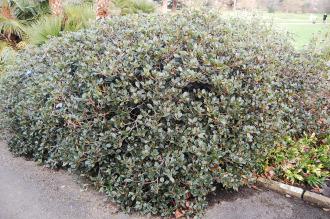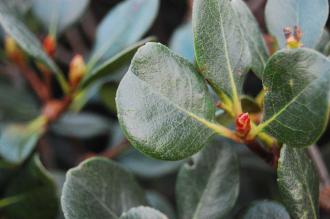
Rhaphiolepis umbellata (16/01/2016, Kew Gardens, London)
Position: Full sun to light shade
Flowering period: Early summer
Soil: Moist, well drained
Eventual Height: 1.5m
Eventual Spread: 1.5m
Hardiness: 7b, 8a, 8b, 9a, 9b, 10a, 10b
Family: Rosaceae
Rhaphiolepis umbellata is a slow growing evergreen shrub with a bushy habit. Its leathery dark green leaves are ovate with entire margins, up to 7cm long and 5cm across. Its fragrant white/ pale pink flowers are up to 2cm across and appear as terminal panicles. Its blue/ black fruit are fleshy berries.
Rhaphiolepis umbellata, commonly known as Yeddow Hawthorn or India Hawthorn, is native to south Japan and south Korea. In its native habitat it grows in mixed scrub.
The etymological root of the binomial name Rhaphiolepis is derived from the Greek rhaphis meaning ‘needle’ and lepis meaning ‘scale’. Umbellata is derived from the Latin umbella meaning ‘parasol’.

Rhaphiolepis umbellata Leaf (16/01/2016, Kew Gardens, London)
The landscape architect may find Rhaphiolepis umbellata useful as an evergreen specimen shrub. It may be maintained as a hedging species. Once established this shrub is somewhat drought tollerant and tolerant of maritime conditions.
Ecologically, Rhaphiolepis umbellata flowers are attractive to pollinating insects. Its fruit are attractive to some birds and mammals.
Rhaphiolepis umbellata prefers moist, fertile, well-drained soils. It tolerates most pH of soil.
Rhaphiolepis umbellata requires little maintenance. Necessary pruning should be carried out after flowering.

Landscape Architecture

